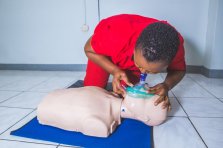
The Heart Foundation of Jamaica (HFJ) continues to push for citizens to be trained in cardiopulmonary resuscitation (CPR) in order to save lives.
Director of Emergency Cardiac Care at the Foundation, Dr. Hugh Wong, said that with 70 per cent of all cases of a sudden cardiac arrest taking place at home, the life saved through CPR could be that of a family member or close friend.
“CPR employs basic manoeuvres that will give someone a chance of surviving until advanced care presents itself. In that respect, physicians the world over support the need for every layperson to learn CPR. It is not difficult,” Dr Wong said.
In outlining the steps in administering CPR, Dr. Wong said that persons must first check for responsiveness by shouting and shaking.
If there is no response then look for signs of life by checking for breathing and a pulse. In the absence of signs of life, persons must always call for help.
Second, either breaths or chest compressions must be administered, but the main focus of CPR should be sustained chest compressions.
This is in keeping with the 2008 training manuals of the American Heart Association, which indicated that in cases where persons are unwilling or unable to do mouth-to-mouth resuscitation, chest compressions alone can save a life.
The next step is the use of the Automated External Defibrulator (AED), after which advanced care should be administered by the first responding health professional such as an emergency medical technician (EMT).
According to medical experts, a defibrillator delivers a dose of electric current (often called a countershock) to the heart.
Following this, the patient should be transported to the nearest health facility, where hospitalised care will be administered.
Dr. Wong, who is a Consultant in Emergency Medicine at the Kingston Public Hospital (KPH), said that properly administering CPR is important, and persons should ensure that they are placing the heels of the hands on the chest, with elbows extended.
They should then compress the chest 30 times, at a rate of 100 to 120 times per minute, then give a breath. If no breath is being given the compressions must be sustained for the entire time.
CPR is a life-saving medical procedure which is given to someone who is in cardiac arrest. It helps to pump blood around the person’s body when their heart cannot. It is designed to support and maintain breathing until emergency medical personnel arrive.
CPR Week was observed from June 16 to 22 under the theme, ‘Every Second Counts; CPR Saves Lives’.
